
Mr. Worst Case Scenario is Digital Trends’ paranoid, squinty-gazed, perpetually on-edge security correspondent. And he’s prepared for anything to go wrong, dammit. This week, he’ll slither out of his underground bunker in Montana, don his tinfoil hat and attend DefCon 2013 in Las Vegas.
If I’ve said it once, I’ve said it a million times: Real cars died the day we stopped installing carburetors and started packing the things full of as many computer modules as possible. And now, just like clockwork, our Frankenstein monsters are coming back for their revenge.
Signs of the trembling undead showed up last month, when Twitter security researcher Charlie Miller – who, you might be interested to know, is also a former NSA hacker – and IOActive’s director of security intelligence Chris Valasek revealed that they had successfully weaseled their way into the computer systems of Ford’s Escape and Toyota’s Prius.
As Miller and Valasek explained in a downright whimsical talk at DefCon on Friday, by burrowing down into the cars’ array of electronic gizmos, the pair has figured out a way to successfully take control of the brakes, steering, acceleration, and even the seat belts of these cars. And they aren’t talking about the kind of helpful control that allows my neighbor George to drive despite not having any arms.
“I think this is where we almost died, right there,” joked Valasek, as he showed off a video of Miller nearly losing control of his hijacked Prius to DefCon. The crowd, of course, just laughed and laughed.
“Like everything else humans have ever made, these systems are going to get hacked.”
Listen, I like jokes as much as anyone. I mean, have you ever seen Carlos Mencia? That guy knows how to lay down a punch-line. Look him up sometime. Know what isn’t funny? Vehicular homicide. And now, thanks to Miller and Valasek, thousands of ambitious DefCon dweebs have the know-how to turn our cars into high-speed killing machines. The problem is so serious, most of us will soon be dreaming of the good ol’ days when the scariest things on the road were old people and Asians. (Ed note: Mr. Worst Case Scenario does not represent the views of Digital Trends.)
I only wish this story ended here. But the future, it seems, holds a whole new set of terrors.
Next on stage, a renowned Australian hacker known as Zoz summed up the situation: “I’m a huge fan of unmanned vehicles. I love robots, I think they’re the future. … But, like everything else humans have ever made, these systems are going to get hacked.”
According to Zoz, who spends much of his time fiddling around with our future overlords, society is hurtling toward a future in which robots, from military drones to civilian unmanned aerial vehicles to Google’s driverless cars, do much of our transportation for us. “Look at all the advantages,” he cheers. Zoz even had the gall to create a robot pizza delivery bot – because what America needs right now is more contraptions stealing our jobs.
“The revolution is coming,” says Zoz. “You can’t stop it, even if you want to.”
After his talk, I’ve never wanted to stop the robot revolution more – especially when it comes to driverless cars.
See, autonomous vehicles use a dizzying array of sensors, maps, GPS, and other clues to avoid flying off a cliff or driving in through your front door. And you might think all that high-tech whizz-bang trumps some jackass hurtling down the road at 60 while texting pictures of his junk. Thing is, says Zoz, every single one of these systems can malfunction – or, worse, be tricked into doing something deadly.
GPS can be jammed or spoofed. Laser range finder can be rendered worthless by tossing a bit of dust or smoke in their path. Millimeter wave radar can’t even handle reflective puddles or even shiny “new asphalt,” says Zoz, without promptly slamming on the brakes, or driving the vehicle straight through whatever it thinks isn’t there. Maps can be remotely manipulated by crafty hackers. And cameras are damn near useless.
Zoz showed off a slew of examples of unmanned vehicles malfunctioning in frightening ways: Driverless cars flying off roadways and catching on fire. Driverless vans driving straight over Jersey barriers. Driverless SUVs plowing into buses full of blind orphans. Okay, that last one didn’t happen – but give it time. Such carnage is inevitable with these four-wheeled terminators.
Driverless SUVs plowing into buses full of blind orphans. Okay, that last one didn’t happen – but give it time.
Then, as if on cue, Zoz busts out with perhaps the most disconcerting fact of them all: “Here’s the key thing,” he says. “When designers watch the robot in action, they don’t necessarily know, even though they programmed the whole thing, why it’s doing what it’s doing.”
Everyone likes to say that driverless cars are the future. That they’ll be safer because they remove the possibility of human error. Turns out, these contraptions will have human error baked right into their soulless hearts.
Just as Zoz started going off on “robot road rage,” I had to flee the room due to a panic-induced asthma attack. I burst outside, and onto the street. As I stood in the oven-like heat, cars buzzed passed me along West Flamingo Road. And then I remembered: Nevada has already legalized the deployment of these unmanned contraptions. I have less than 48 hours left in this hellhole. Here’s praying I make it out alive.
Over and out.


